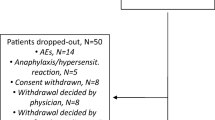Abstract
Background
We aimed to assess the tolerability, pharmacokinetics, safety, and efficacy of sargramostim in Japanese patients with active Crohn’s disease (CD).
Methods
Patients with moderately to severely active CD were enrolled. Step 1 was an open-label, phase 1 study of 2 μg/kg per day sargramostim administered subcutaneously (SC) for 4 weeks, with an optional 8-week extension with 6 μg/kg per day. Step 2 was an open-label, phase 1–2 study of the tolerability and pharmacokinetics of SC sargramostim 6 μg/kg per day over 4 weeks and of 8-week efficacy and safety. Efficacy variables were the proportion of patients achieving a clinical response [≥100-point decrease from baseline in the CD activity index (CDAI)] and the proportion achieving clinical remission (CDAI ≤ 150 points).
Results
Six patients participated in Step 1; five in Step 2. Serum concentrations of sargramostim peaked within 1 h of administration; mean terminal half-life was 2 h. Maximal serum concentrations increased with the dose. Mean accumulation ratios were 0.998 in Step 1 and 0.673 in Step 2. One of the six patients in the Step-1 extension and none of the five in Step 2 achieved a clinical response. Clinical remission was reported in one patient in each step. A notable decrease in median CDAI scores was observed in the extension and Step 2. In responders, improvement tended to be maintained through the 30-day follow-up. Drug-related adverse events included injection-site reaction, pyrexia, back pain, and bone pain.
Conclusion
The systemic exposure of sargramostim increased dose-dependently. No accumulation in systemic exposure was associated with the repeated once-daily administration. SC sargramostim at 6 μg/kg per day improved median CDAI scores. A minority of patients experienced clinical remission or clinical response.

Similar content being viewed by others
References
Loftus EV Jr, Schoenfeld P, Sandborn WJ. The epidemiology and natural history of Crohn’s disease in population-based patient cohorts from North America: a systematic review. Aliment Pharmacol Ther. 2002;16:51–60.
Podolsky DK. Inflammatory bowel disease. N Engl J Med. 2002;347:417–29.
Korzenik JR, Dieckgraefe BK, Valentine JF, Hausman DF, Gilberg MJ, Sargramostim in Crohn’s Disease Study Group. Sargramostim for active Crohn’s disease. N Engl J Med. 2005;352:2193–201.
Korzenik JR, Dieckgraefe BK. Is Crohn’s disease an immunodeficiency? A hypothesis suggesting possible early events in the pathogenesis of Crohn’s disease. Dig Dis Sci. 2000;45:1121–9.
Wilks JN, Viney JL. GM-CSF treatment for Crohn’s disease: a stimulating new therapy? Curr Opin Investig Drugs. 2002;3:1291–6.
Armitage JO. Emerging applications of recombinant human granulocyte-macrophage colony-stimulating factor. Blood. 1998;92:4491–508.
Fukuzawa H, Sawada M, Kayahara T, Morita-Fujisawa Y, Suzuki K, Seno H, et al. Identification of GM-CSF in Paneth cells using single-cell RT-PCR. Biochem Biophys Res Commun. 2003;312:897–902.
LEUKINE® (sargramostim). Bayer HealthCare Pharmaceuticals, Seattle, WA. Revised April 2008. http://www.leukine.com/hcp/index.jsp. Accessed 28 Sept 2008.
Neumunaitis J, Rosenfeld CS, Ash R, Freedman MH, Deeg HJ, Appelbaum F, et al. Phase III randomized, double-blind placebo-controlled trial of rhGM-CSF following allogenic bone marrow transplantation. Bone Marrow Transplant. 1995;15:949–54.
Jones SE, Schottstaedt MW, Duncan LA, Kirby RL, Good RH, Mennel RG, et al. Randomized double-blind prospective trial to evaluate the effects of sargramostim versus placebo in a moderate-dose fluorouracil, doxorubicin, and cyclophosphamide adjuvant chemotherapy program for stage II and III breast cancer. J Clin Oncol. 1996;14:2976–83.
Meropol NJ, Rustum YM, Creaven PJ, Blumenson LE, Frank C. Phase I and pharmacokinetic study of weekly 5-fluorouracil administered with granulocyte-macrophage colony-stimulating factor and high-dose leucovorin: a potential role for growth factor as mucosal protectant. Cancer Invest. 1999;17:1–9.
Korzenik JR, Dieckgraefe BK. An open-labelled study of granulocyte colony-stimulating factor in the treatment of active Crohn’s disease. Aliment Pharmacol Ther. 2005;21:391–400.
Dieckgraefe BR, Korzenik JR. Treatment of active Crohn’s disease with recombinant human granulocyte-macrophage colony-stimulating factor. Lancet. 2002;360:1478–80.
Valentine JF, Fedorak RN, Fredlund P, Feagan BG, for the Sargramostim CD Study Group. Sargramostim induces steroid-free remission in corticosteroid-dependent Crohn’s disease: results of NOVEL 2, a phase II multicenter study. Presented at Digestive Diseases Week, Washington DC, 19–24 May 2007.
Bayer HealthCare. Phase 3 randomized, double-blind, placebo-controlled induction study of sargramostim (Leukine®) in subjects with active Crohn’s disease. http://www.clinicalstudyresults.org/drugdetails/?inn_name_id=474&sort=c.company_name&page=1&drug_id=2435. Accessed 28 Sept 2008.
Acknowledgments
We thank the members of the NOVEL 9 Study Group. Medical writing assistance and editorial support were provided by Adelphi Inc. and were funded by Bayer Yakuhin Ltd.
Author information
Authors and Affiliations
Corresponding author
Rights and permissions
About this article
Cite this article
Takazoe, M., Matsui, T., Motoya, S. et al. Sargramostim in patients with Crohn’s disease: results of a phase 1–2 study. J Gastroenterol 44, 535–543 (2009). https://doi.org/10.1007/s00535-009-0029-7
Received:
Accepted:
Published:
Issue Date:
DOI: https://doi.org/10.1007/s00535-009-0029-7




